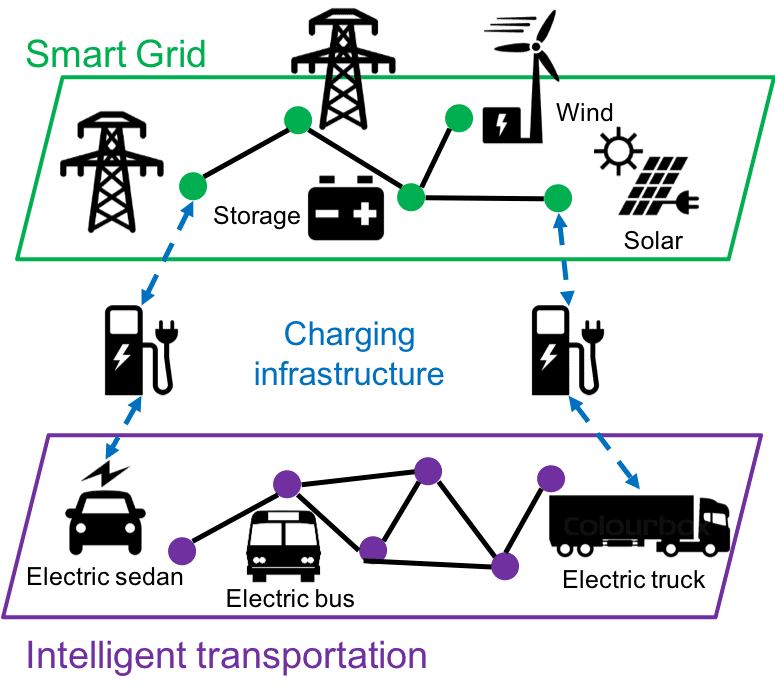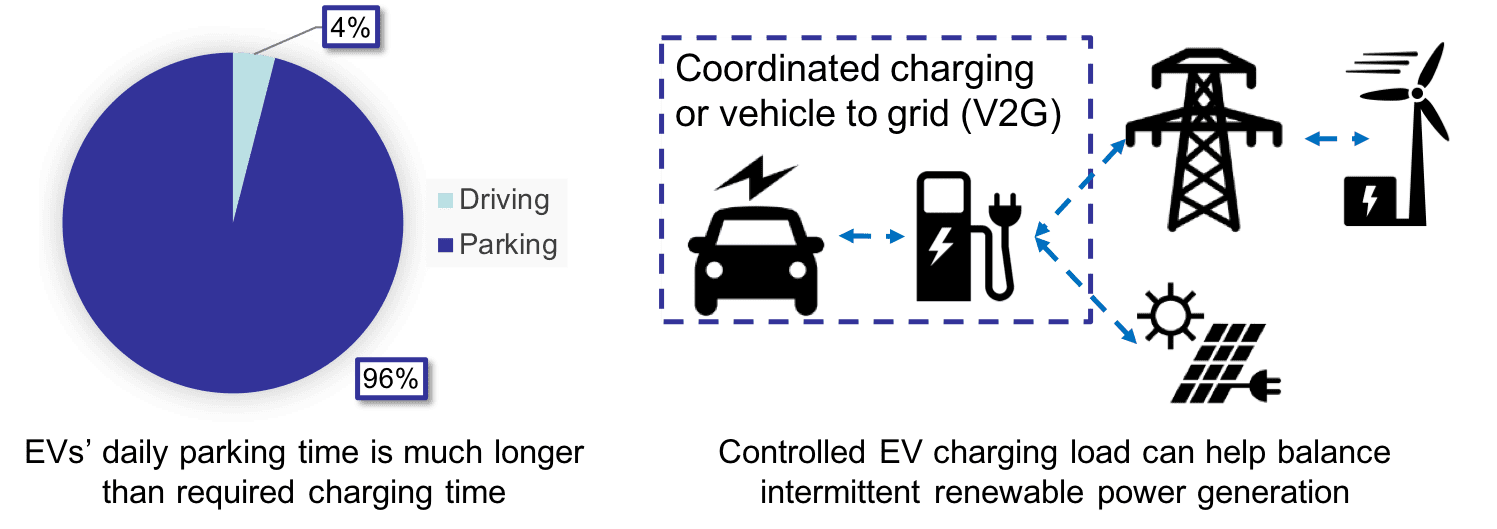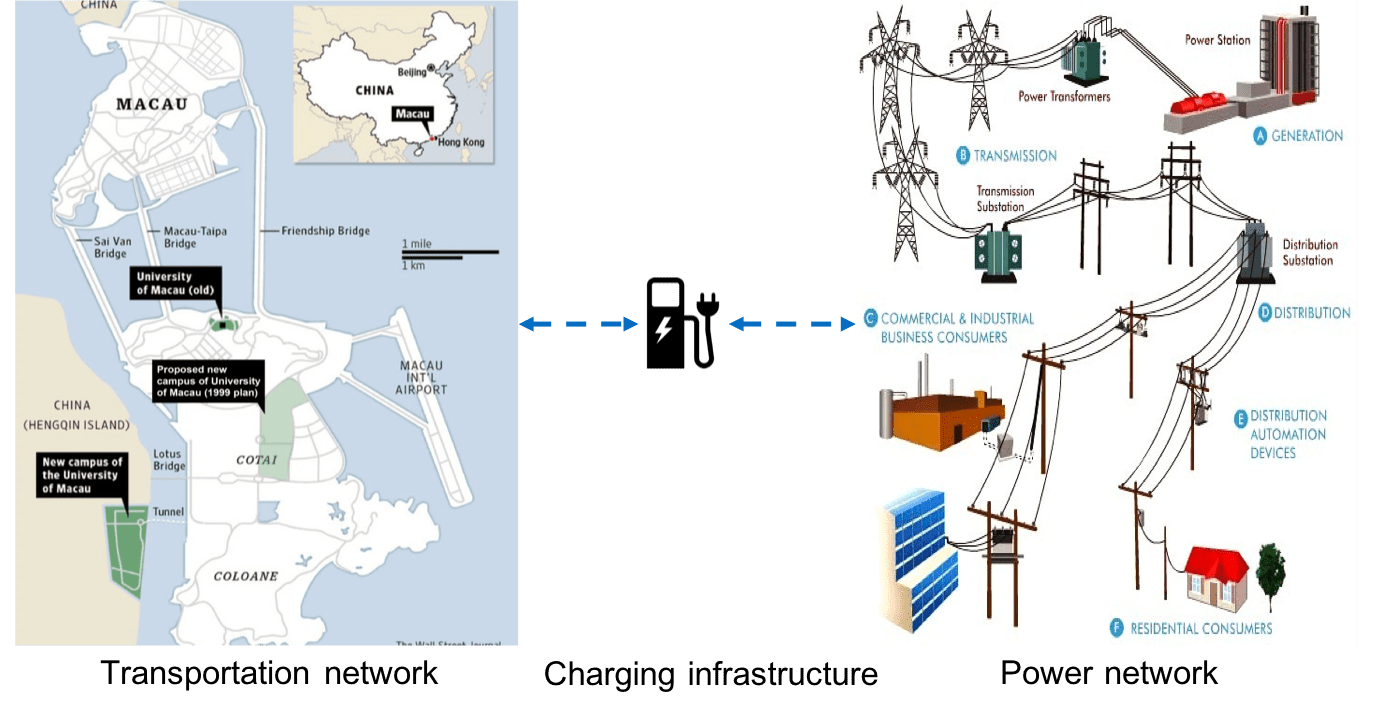The synergy between the smart power grid and the intelligent transportation is one of the major features of future smart city. During the last decade, the electric vehicle (EV) industry has experienced an explosive growth worldwide as a result of strong government promotion and technological advances. Along with the increase of PEV population, the scale of charging infrastructure is also booming.
Increasing EV charging stations are coupling power and transportation systems, two type of critical social systems, tightly together. On one hand, the future distribution of EV traffic flows will be constrained by both transportation network parameters and electric power supply capacities (or costs). On the other hand, the distribution of EV traffic flows will not only impact the transportation network efficiency, e.g., traffic congestions, but also the distribution of power flows, and, thereafter, the economic efficiency of the coupled power grid. Besides, though EVs are regarded as a promising tool to decarbonize transportation systems and combat climate change, their emission advantages depend heavily on the co-related electricity generation mix for charging. Without clean electricity supply, EVs may emit more than electric-gasoline hybrid or internal combustion engine vehicles.

Synergy between smart power grid and intelligent transportation system
Because of the aforementioned reasons, the Smart Energy Group in the SKL-IOTSC have been working on the integration of EVs into future power and transportation systems for years, mainly focusing on the following topics:
Coordinated charging or vehicle-to-grid (V2G) for large-scale EVs: An EV parks for over 90% of its life time and its necessary charging duration is much shorter than its parking duration. Hence, an EV’s charging load is quite flexible. Utilizing V2G technologies, a group of EVs can form a V2G fleet under the control of an aggregator; this fleet can behave like a storage system, e.g., arbitraging in the energy market, providing ancillary services, and promoting the integration of renewable resources etc. The Smart Energy Group have been working on aggregate modeling, distributed or hieratical controlling and market participation strategies for large-scale EVs to achieve the aforementioned benefits.

Vehicle to grid
Charging infrastructure planning for EVs: Since EV charging stations couple transportation and power networks, their locations and sizes not only affect EV driving behavior, but also significantly impact transportation and power network operation. Therefore, the planning of charging stations should take both transportation and electrical constraints into consideration. The locations and sizes of EV charging stations in a transportation network should satisfy EV driving demands, while simultaneously ensuring the security operation constraints of power systems, e.g., distribution line current limits and nodal voltage limits. In addition, an appropriate charging station planning method should minimize the investment costs of both charging stations and corresponding power grid upgrades. The Smart Energy Group adopt interdisciplinary approach to site and size EV charging station considering coupled power and transportation network constraints to maximize social welfare.

Electric vehicle charging system planning consider coupled power and transportation constraints
Synergy between smart power grid and intelligent transportation: Increasing EV charging stations are coupling the power and transportation systems tightly together. The distribution of EV traffic flows will be constrained by and inversely affect both systems. How the two systems will interact with each other and how should we manage further large-scale EVs in the city to promote the efficiency of both power and transportation systems are curtail questions that we need to answer. The Smart Energy Group work on the mechanisms of power and transportation nexus and optimal operation of EV fleet considering the nexus to provide insights for both EV fleet operators and city policy makers.

Electric vehicle routing considering synergy between power and transportation systems
Optimization and operation of autonomous electric vehicle fleet: Besides transportation electrification, autonomous driving is another major disruptive technology that is reshaping our transportation systems. Autonomous vehicles (AVs) that transport passengers or goods without human intervention will not only free human drivers from burdensome driving labor, but also promote transportation accessibility, cut down mobility costs, enhance energy efficiency, and reduce green- house gas emission. When AVs are electrified, which we refer to as autonomous electric vehicles (AEVs), then the last two aforementioned advantages will be further enhanced, particularly if the electricity is supplied from clean energy (e.g., renewable power generation). Passenger (e.g., ride-hailing) and goods transportation are clear initial markets for AEV fleets. Specifically, they feature high utilization levels and planned routes, which can exploit the aforementioned advantages of AEVs. The Smart Energy Group work on charging infrastructure planning and fleet operation strategies for ride-hailing AEVs considering transportation and power nexus aiming to provide systematic solutions for future AEV fleet operators.

Charging system planning and routing for autonomous electric vehicles
Relevant publication
- H. Zhang, Z. Hu, Z. Xu, and Y. Song, “Evaluation of Achievable Vehicle-to-Grid Capacity Using Aggregate PEV Model,” IEEE Transactions on Power Systems, vol. 32, no. 1, pp. 784-794, 2017.
- X. Chen, H. Zhang, Z. Xu, C. P. Nielsen, M. B. McElroy, and J. Lv, “Impacts of Fleet Types and Charging Modes for Electric Vehicles on Emissions under Different Penetrations of Wind Power,” Nature Energy, vol. 3, pp. 413-421, 2018. (equal contribution)
- H. Zhang, Z. Hu, E. Munsing, S. J. Moura, and Y. Song, “Data-driven Chance-constrained Regulation Capacity Offering for Distributed Energy Resources,” IEEE Transactions on Smart Grid, vol. 10, no. 3, pp. 2713-2725, 2019.
- H. Zhang, S. J. Moura, Z. Hu, W. Qi, and Y. Song, “A Second Order Cone Programming Model for Planning PEV Fast-Charging Stations,” IEEE Transactions on Power Systems, vol. 33, no. 3, pp. 2763-2777, 2017.
- H. Zhang, S. J. Moura, Z. Hu, W. Qi, and Y. Song, “Joint PEV Charging Network and Distributed PV Generation Planning Based on Accelerated Generalized Benders Decomposition,” IEEE Transactions on Transportation Electrification, vol. 4, no. 3, pp. 789-803, 2018.
- H. Zhang, S. J. Moura, Z. Hu, and Y. Song, “PEV Fast-Charging Station Siting and Sizing on Coupled Transportation and Power Networks,” IEEE Transactions on Smart Grid, vol. 9, no. 4, pp. 2595-2605, 2018.
- H. Zhang, C. J. R. Sheppard, T. E. Lipman, and S. J. Moura, “Joint Fleet Sizing and Charging System Planning for Autonomous Electric Vehicles,” under review in IEEE Trans. Intell. Transp. Syst.(2nd round).
- H. Zhang, C. J. R. Sheppard, T. E. Lipman, T. Zeng, and S. J. Moura, “Charging Infrastructure Demands of Shared-Use Autonomous Electric Vehicles in Urban Areas. ” under review in Transportation Research Part D: Transport and Environment(2nd round).
- H. Zhang, Z. Hu, and Y. Song, “Power and Transport Nexus: Routing PEVs to Promote Renewable Generation Integration.” under review in IEEE Trans. Smart Grid. (1st round).



